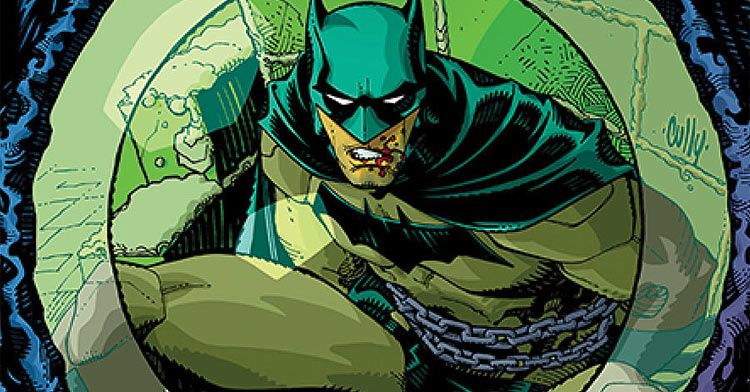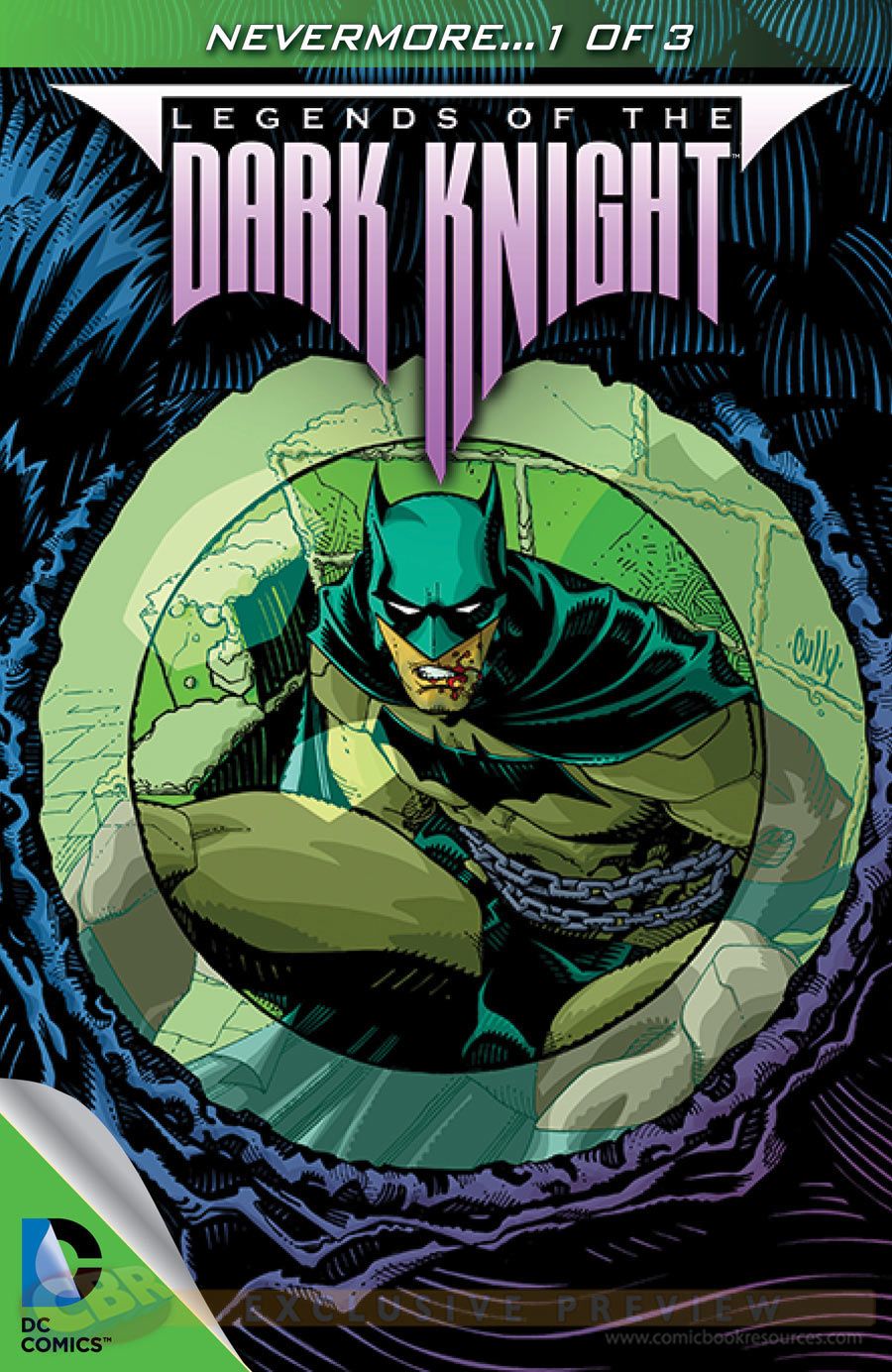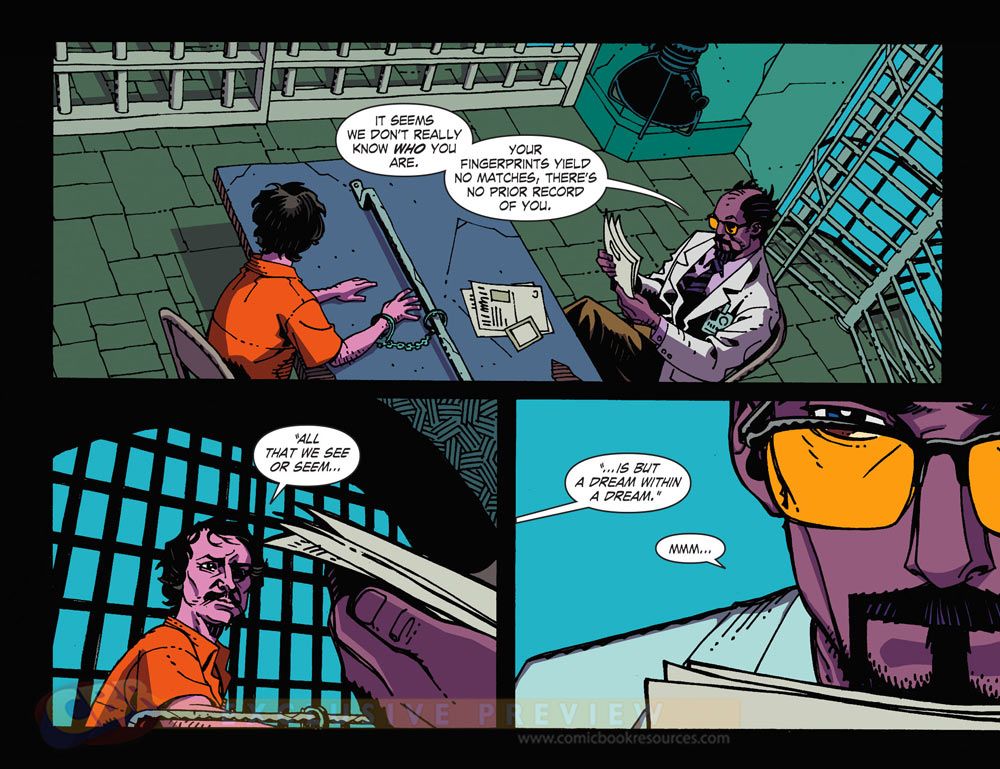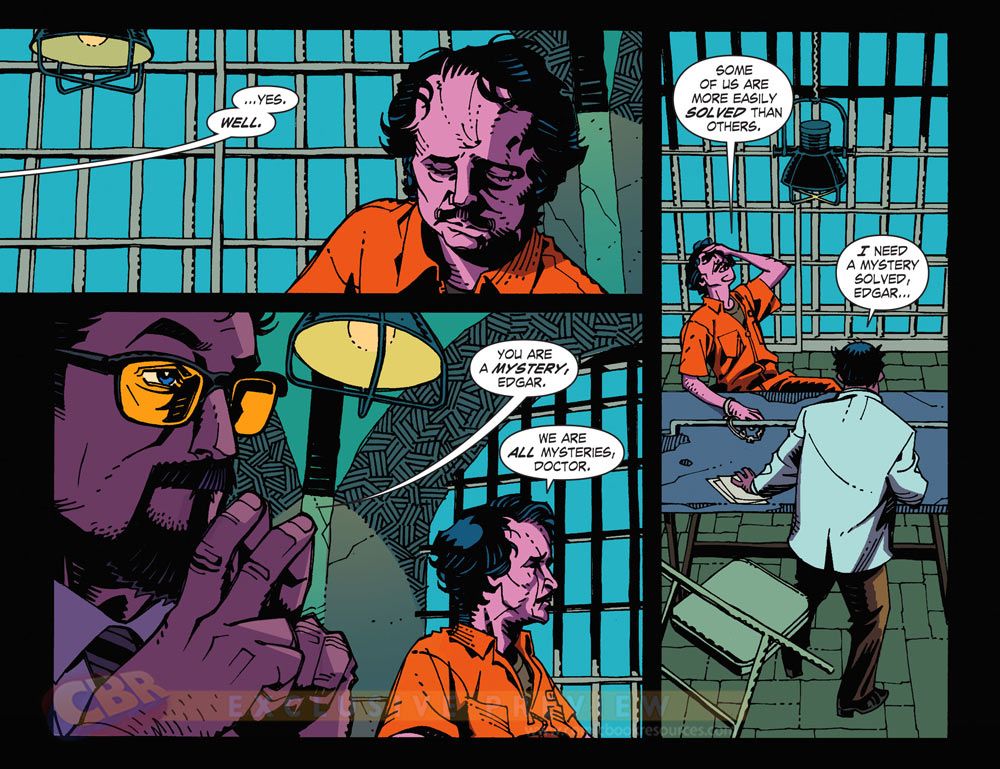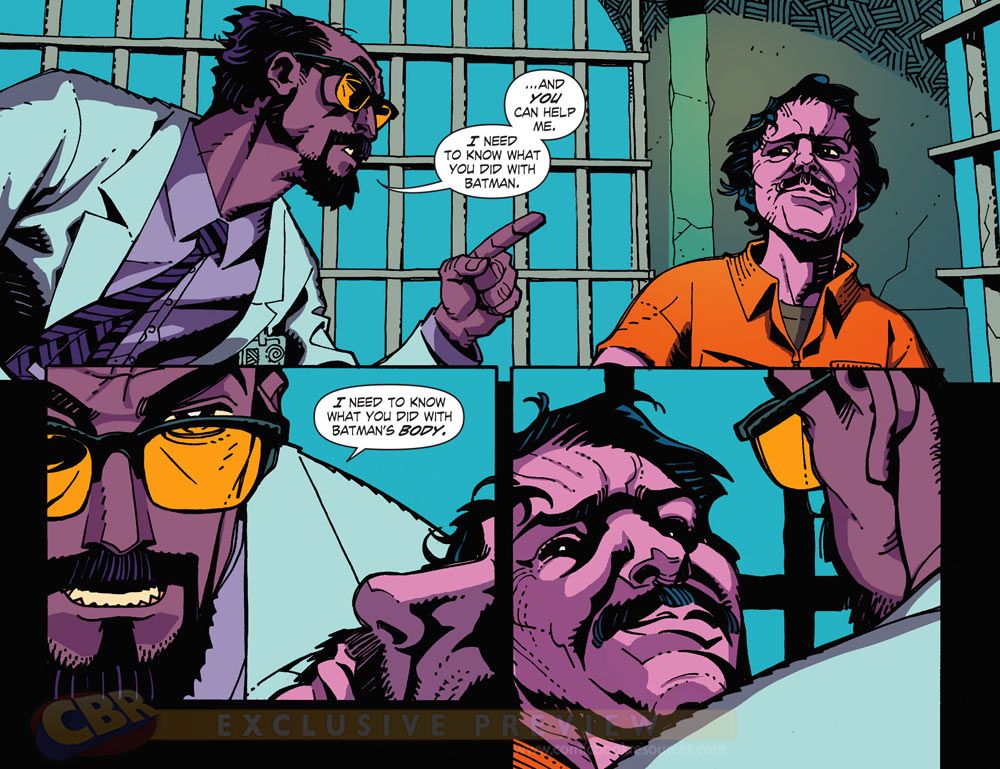DC Comics' digital-first "Legends of the Dark Knight" series returns today with the first of three new chapters. And CBR News has an exclusive sneak peek of "Nevermore," the first chapter of a three-part story arc written by Ron Marz and featuring art by Cully Hamner.
Both long-time Batman fans, Marz and Hamner have been friends for years, so when Hank Kanalz, the Senior Vice President of Vertigo and Integrated Publishing at DC Comics, offered an opportunity to collaborate on a story, the dynamic duo jumped at the chance.
In "Nevermore," the Caped Crusader comes face-to-face with Edgar Allan Poe -- sort of. Faux Poe, as he is referred to by Hamner, is a rogue who shares not only the likeness of the legendary literary giant, but his passion for the macabre as well.
Marz and Hamner also shared their thoughts on Batman's never-ending coolness factor after 75 years of publication and why Poe has endured an even longer reign of terror as literature's horror master.
CBR News: Any time you get the call to work on Batman, is it a no-brainer to accept?
Ron Marz: Oh yeah, absolutely. Everybody has a Batman story to tell. Probably most of us have more than one Batman story to tell. [Laughs] So when you get the chance, you say "yes." Absolutely.
Cully Hamner: Agreed. Batman is one of my favorite characters, going back to when I was learning to read. It's a character that I have always responded to and had a love for and always come back to, even as a reader. I've always jumped at the chance when I've got one to draw him. But honestly, I've rarely had a chance to do a Batman story. This was a nice change.
What is it about Batman that after 75 years he remains so popular with readers and creators?
Marz: He's the best comic book character, because he just is. Part of that is the elasticity of the character. You can tell different kinds of stories with Batman. You can do crime. You can do horror. You can do more outlandish superhero/supervillain kinds of things. Batman has had so many different interpretations over the decades that there is really a wide range of material that you can cover, and appropriately so, with the character.
What resonates with you about Batman, as an artist, Cully?
Hamner: I'm not the kind of artist that has a lot of other artists' work spread out on my table. At this point, I'm pretty comfortable in my skin as far as what I do. Anything that I do that is kind of off my beaten path is always going to be dictated by story. Whatever the story calls for. And I have my own ethic about how I approach anything, so it's always going to look the way that I draw. I never do a story where I say, "Here is my Mignola," or, "Here is my Neal Adams." I'm always going to try and bring to it what I can bring to it. To me, that's something that's not really fair to the character, to do somebody else's version. It's not fair to the character. It's not fair to Ron. And it's not fair to anybody. I would rather do the best Cully Batman that I can do.
Specifically, I have a particular way that I draw the cowl, and I always enjoy drawing Batman's face. The cape is always something that I have to think about much more than the rest of the costume. The cape, in a weird way, is another appendage. I hesitate to use the cliche that it is a character unto itself, but it is very definitely a touchstone of the visual style of the character. Everybody approaches it differently, and I'll be honest -- I am still figuring it out. I've drawn Batman as a character professionally, but I have drawn him as a fan since I was a kid, just for myself. I am still figuring out how I handle that cape. If you can come up with a distinctive way to handle it, that's an accomplishment. Hats off to somebody like Todd McFarlane, back in the 1990s, who figured out a way to draw that cape that was so different than everybody else. A lot of guys have figured out their Batman, and for me, it's an ongoing process. It's part and parcel that I have so rarely drawn him that I am still trying to figure him out.
Do you have to do anything differently as a creator when setting out to do a story as a digital first?
Marz: The format is a little bit different because each single page of a print comic is split in half, horizontally, for the web application. Each chapter is 10 pages, but you're really writing 20 half-pages. It's not a huge difference in terms of the story that you tell, but it's somewhat different in terms of how you tell the story because you actually have an extra page turn on every page. You have to think in half-page units in addition to whole-page units.
Hamner: There was a mild set of marching orders, visually, for this in the sense that when Hank Kanalz engaged us to do this, one thing that I had to keep in mind was rather than reading a comic in what artists call portrait-style, which is when the page is taller than it is wide, we had to think about, people are going to be reading this on a device, which would tend to be wider than it is taller, or landscape-style.
The way it is set up is that you draw a page normally, in the sense that the dimensions of the comic page are the same, but every page has to be divided down the center. Essentially, you are drawing two pages on one piece of paper. I did have to keep that in mind. Every page had to essentially have a top and a bottom, with a pretty definite dividing line right across the middle of the page. You can look at that as a limitation, or you can look at that as part of the song that you are singing. You have to phrase it a certain way to make it work and that was how I looked at it. I picked it up pretty quickly in terms of making the layout work. I have no problems doing layouts for a story that are a little more on the traditional side. That's what I tend to do anyway. It worked out fine for me.
So, you connect with Hank, and he asks you if you have a Batman story idea. And you say, "Yep. He's going to face Edgar Allan Poe." Easy sell, right?
Marz: Again, it was Hank Kanalz from DC that reached out to me and asked the question that you always want to hear: "Do you have a Batman story?" And my answer was, "Duh." I pitched three or four different stories, and this is the one that I wanted to tell by far the most. I don't even remember the other ones, at this point. This one just came to me fully-formed, and thankfully, it's the one that they picked. It fell together really easily and gave me an excuse to go back and read a lot of Poe short stories.
Cully, when you heard the supervillain was not The Joker, Penguin or Riddler, but Edgar Allan Poe, you just responded and said, "Yes. That makes perfect sense." [Laughs]
Hamner: Yes, exactly. [Laughs] No, but seriously, this version of Faux Poe that Ron has come up with is in the tradition of Batman villains in that he is crazy. He's nuts. There is nothing sane about this guy. On that front, he's right up there with so many of the classic villains that I was ready to jump right in on it.
You said "Faux Poe," so you concede that this isn't actually Edgar Allan Poe?
Marz: We can probably reveal that Batman didn't travel back in time to the 19th Century for this story. [Laughs]
What makes Faux Poe a perfect adversary for Batman?
Marz: They are both very dark characters with a Gothic sensibility hanging over them. Certainly, Poe is less a character than a historical figure, but his whole personality works. There is this whole dark, tormented writer that literally died drunk in a gutter, but basically left behind the seeds that would become the modern detective story and so many things that became horror tropes. It just seemed that there was a natural kinship between the two characters.
I've been a Poe fan since literally elementary school. I just thought visually that Poe and some of his characters would just work really well in Batman's world.
Hamner: Yes, for sure. My experience with Poe is a bit different from Ron's -- Ron is a Poe fanboy, he's read everything -- and I am not. My exposure to Poe has been mainly through adaptations, like movies and comics and cartoons. I haven't really read much in terms of Poe, maybe one or two of the most famous stories. So mainly what I respond to is the way that Poe has been interpreted, visually, in media. And obviously, yes, that tone fits very neatly into the dark world of Gotham and Batman.
Marz: Exactly. The more well known stuff like "The Raven," "The Black Cat," "The Fall of the House of Usher," "The Cask of Amontillado" -- all of that stuff is so atmospheric, and a lot of it is, really, pretty short, as opposed to a modern short prose story, but I think a big part of Batman is also atmosphere. And the feel that you get out of a Batman story, particularly a Batman story set in Gotham City, just seems that there is a kinship there in terms of tone that made the two characters match.
Also, not to put too fine a point on it, but Edgar Allan Poe was certainly at best a manic depressive, maybe bipolar. The guy had issues. And a great many of Batman's villains have issues, shall we say.
And so do their henchmen and thugs. Hop-Frog comes to mind.
Hamner: Yes. [Laughs] Hop-Frog was a lot of fun to draw. Again, I'm not a Poe reader. I was not particularly familiar with the specifics about the characters from Poe's stories, so I had to do some research, and some of it is not really well defined in terms of what the characters were supposed to look like. There are a lot of blanks to fill. For a character like Hop-Frog, I knew he had to be dressed like a jester, but I didn't know how caveman-ish or ape-ish to make him. That was really interesting to do.
"Legends of the Dark Knight" Chapter 80 by Ron Marz and Cully Hamner featuring part 1/3 of "Nevermore" is on sale now.
The next two chapters of "Nevermore" go on sale Friday, December 12 and Friday, December 19, followed by a two-part arc by J. Torres and Matthew Clark, which will be released on Friday, January 2 and Friday, January 9.

